My exposure to handguns dates back to 1957 or so, thanks to an American Legion sponsored youth competitive shooting group and older neighborhood friends; a 38 of some type, specifics beyond my youthful understanding, a Luger revived from a trigger brazed to trigger guard DEWAT that went REWAT and a series of 1911 Government Model Colts shot in competition. Not seeing much practical use for a handgun, interest waned after a couple of years.
Military service put me in touch with handguns again, something to carry when flying along on SEA sorties and then for small game hunting when fish weren’t biting in South Dakota’s the Black Hills. In 1968, after a good deal of family discussion and budgeting, a Ruger Old Model Single Six with 22 LR and 22 Mag cylinders was purchased for the huge sum of $86. I do not believe they were called “convertibles” at the time, but they could have been. It was a long time ago and there was no Google to create the appearance of knowledge.
| Ruger Single Six Convertible |
|
| Manufactured | Newport, NH |
| Model Number | 0625 |
| Type Action | Single |
| Caliber | 22 LR / 22 WMR |
| Capacity | 6 |
| Construction | Stainless Steel |
| Grips | Hardwood |
| Trigger Pull |
4 Lbs 7 Oz |
| Barrel Length | 5.5″ |
| Rifling | 1:14″ |
| Rear Sight | Adjustable W/E |
| Front Sight | Ramp |
| Type Safety | Transfer Bar |
| Overall Length | 11.0″ |
| Weight | 39.0 Oz. |
| MSRP | $699 |
Over the years, the Single Six has gone through many changes in barrel length, materials, process and cartridges. Cylinder frames have been fashioned from aluminum and steel, grip frames and even cylinders made of the same.
In 1973, the New Model Single Six came along and the safety of a transfer bar to prevent accidental discharge, two steel pins that would not back out replace screws from the early model, the front sight was improved, the hammer went to two positions and the half cock position was retired.
Subjected to 100,000 dry fires without failure, in 1984 it’s frame and cylinder was deemed stout enough to handle the 32 H&R Magnum and, more recently, the 327 Federal Magnum.
I learned a couple of life lessons almost immediately. My wife is a much better shot with handgun and remains so today. I also learned that a jacketed 22 WMR bullet tended to kill by paper punching through rabbits and squirrels rather than breaking apart as was the case with the 22 LR lead bullets. The only downsides for the 22 WMR were the extra cost and the elimination of the joys of lead surprise when biting into the cooked version of small game.
Changeover between 22 LR and 22 Mag cylinders is quick and easy; open the loading gate, depress the spring loaded base pin latch… I usually tell it we are having PB&J on whole wheat for lunch, pull the base pin and the cylinder will roll out on the loading gate side. Reverse the procedure but use a different line to depress as it would have already learned to cope with the lunch situation.
I’m listening to Lake Shore Dive with Rachael Price lead vocalist. They have an incredible repertoire of songs, but few that showcase Price’s incredible voice and grasp of the dramatic. “Mistakes” or “What I’m doing here” are genius but the rest, to me, are as bromide pop as Taylor Swift or only useful as Samba music. I need to find a better music backdrop for writing. The Rolling Stones can only take me so far. Hey, Townes Van Zandt?
Rimfires… or is it rim fires?
There are currently eight SAAMI defined rimfire cartridges:17 Mach 2, 17 Hornady Magnum Rimfire, 17 Winchester Super Magnum, 22 Short, 22 Long, 22 Long Rifle (Match, Sporting & Shot), 22 Winchester Rimfire, 22 Winchester Magnum. The subject Single Six accommodates the 22 Short, 22 Long, 22 Long Rifle, and 22 Winchester Magnum by using the appropriate cylinder as specifically addressed in the pistol’s manual.
The 22 Short, introduced as the first American rimfire was introduced in 1857, is still useful as a utility cartridge for recreational firearms. Close in, the 22 short is excellent for varmint control and it is relatively quiet. Testimony to its potential for accuracy can be found in the cartridge’s use in International Olympic level competition. From a cost standpoint, it is mostly the same price as 22 Long Rifle ammunition.
The 22 Long has been around since 1871, predating the 22 Long Rifle by sixteen years. The Long Rifle was introduced in 1887 and is the highest volume ammunition sold world wide. Current factory ammunition performance to SAAMI standard is midway between the 22 Short and Long Rifle. Using bullet weights between 29 grains and 31 grains for a common point of reference, short, long and long rifle velocities in feet per second are, respectively: 1,080, 1,215, 1,550. The 22 Short has a MAP pressure of 21,000 psi, 24,000 for the 22 Long and the 22 Long Rifle. The 22 Winchester Mag, introduced in 1959, is rated at 2,200 fps with 30 grain bullets and a 24,000 psi SAAMI Maximum Average Pressure.
From a cost standpoint, 22 Short ammo runs between nine and ten cents per round, a combined five types of ammo from three manufacturers. There is currently only one company, CCI, producing one type of 22 Long ammunition priced nine cents per round. Long Rifle shooters have a slight edge in supply, yes that is sarcasm, with one hundred-five factory loads coming from thirteen sources. Long Rifle ammunition is priced from three cents for recreational ammunition to forty cents per round for target grade ammunition. Prices are really dropping. perhaps manufacturers who gouged during periods of ammunition shortages and charged as much as ten dollars per box of fifty rounds realized they were killing all shooting sports?
The are currently twenty-five types of 22 Winchester Magnum Rimfire cartridges coming from eight sources, with prices running between eighteen and thirty-four cents per round. Why the significantly higher price? More brass, more powder, a much more costly jacketed bullet, and capitalism at work as 223 Remington centerfire rifle ammunition is available at thirty cents per round.
OK, I am done grousing about how prices have risen since 1857…
At  the introduction, and shortly there after, there was a good deal of gun writer hubbub regarding bore/groove diameter and accuracy of the set up with two cylinders. The 22 Long Rifle bullet spec is 0.2255″ -0.000″/+0.004″. The jacketed 22 WMR bullet spec is 0.2245″ +0.000″/-0.004″. However, the 22 long rifle bullet at the core is 0.2040″, with driving bands 0.2255″ in diameter. Additionally, where the 22 WMR has a uniform shank diameter like a centerfire round, the 22 long rifle and it is a heeled bullet, meaning the base of the bullet retained inside the case is of smaller diameter, approximately 0.204″ below the crimp groove.
the introduction, and shortly there after, there was a good deal of gun writer hubbub regarding bore/groove diameter and accuracy of the set up with two cylinders. The 22 Long Rifle bullet spec is 0.2255″ -0.000″/+0.004″. The jacketed 22 WMR bullet spec is 0.2245″ +0.000″/-0.004″. However, the 22 long rifle bullet at the core is 0.2040″, with driving bands 0.2255″ in diameter. Additionally, where the 22 WMR has a uniform shank diameter like a centerfire round, the 22 long rifle and it is a heeled bullet, meaning the base of the bullet retained inside the case is of smaller diameter, approximately 0.204″ below the crimp groove.
The greater difference between the 22 LR and 22 WMR is in the bore and groove diameters, each determined to provide optimal accuracy with each respective cartridge. The 22 LR has a bore diameter of 0.217″ and a groove diameter of 0.222. The 22 WMR has 0.219″ bore and 0.224″ groove diameters like centerfire cartridges that also utilize jacketed bullets. It was thought, in those olden days when engineers rather than Facebook determined good practices, that the Ruger with 22 WMR bore and groove dimensions would be accurate shooting 22 WMR cartridges, but not with the 22 LR cylinder in place. I believe that gun writers determined that the 22 LR bullet would leave the case at an acute angle, bounce off the rifling, ricochet left, and then tumble the remaining length of the barrel.. which, in retrospect, is a lot like Facebook.
My early test was conducted one day at Deerfield Lake, South Dakota, when I took a break from trout fishing to pop some rabbits. First I shot one in the head with a 40 grain 22 Mag. It was dead. I switched cylinders, loaded up and shot another rabbit in the head. It was also dead. Based on that exhaustive testing, I would say the 22 LR configuration was not inaccurate. But I am as old as tree bark now, I don’t often shoot rabbits anymore… unless they really have it coming, so I retested with paper targets. Please, don’t write and tell me I am a rabbit hater. I love rabbits.
Upon further consideration…
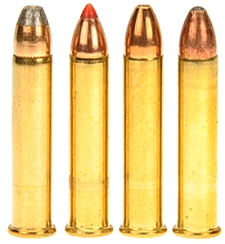 The four 22 Mag cartridges pictured left were selected…. because they were closest to the front of the inventory bin and they showed character. They appear on the table, top to bottom, as they appear in the picture left to right:
The four 22 Mag cartridges pictured left were selected…. because they were closest to the front of the inventory bin and they showed character. They appear on the table, top to bottom, as they appear in the picture left to right:
| Ammunition | Bullet Weight Grains |
Rated FPS 24″ Barrel |
Actual FPS 5.5″ Barrel |
50′ 3 Shot Group “ |
| Winchester Super X | 28 | 2,200 | 1,745 | 0.6 |
| Hornady V-Max | 30 | 2,200 | 1,515 | 1.2 |
| CCI TNT | 30 | 2,050 | 1,394 | 1.0 |
| CCI GamePoint | 40 | 1,875 | 1,360 | 0.6 |
I do not know what the scale is from Internet groups to real world groups, but I felt the 22 Magnum groups were excellent. Yes, they are three shot group, only because I could never see the need for five shot groups. I can’t remember having to shoot game in the same spot five times and because I can get two, three shot groups out of a six gun cylinder full, which makes my life easier. But there is more… so much more.
The five 22 LR cartridges pictured left were selected…. because they were closest to the front of the inventory bin and they showed character. They appear on the table, top to bottom, as they appear in the picture left to right:
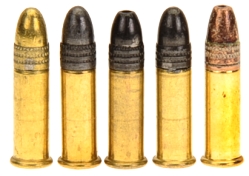
| Ammunition | Bullet Weight Grains |
Rated FPS 24″ Barrel |
Actual FPS 5.5″ Barrel |
50′ 3 Shot Group “ |
| Remington Golden Bullet | 40 | 1,255 | 1,026 | 0.4 |
| Remington Thunderbolt | 40 | 1,255 | 916 | 1.3 |
| Remington Cyclone | 36 | 1,280 | 1,153 | 0.8 |
| Remington Target | 40 | 1,150 | 958 | 0.5 |
| Federal Champion |
36 |
1,280 |
1,030 |
1.0 |
The above has pretty much been my experience with the Single six and similar ammunition. Groups can be tightened by sifting through brands and types to find the optimal performance. Yes, it cost money to do this, but then you are spending time shooting, which is a good thing. For my purposes, each category of Mag or LR have ammunition that demonstrated better than necessary performance.
A closing perspective
The Ruger Single Six, if you’ll forgive a cliche, is in a class of its own. It is engineered and built to last and perform from one generation of owner to the next. It is not cheap in price, but then it isn’t cheaply made, which makes it a value. For the person who buys quality tools for their precision and longevity, the Ruger Single Six is more of the same. Made in America, an American tradition.

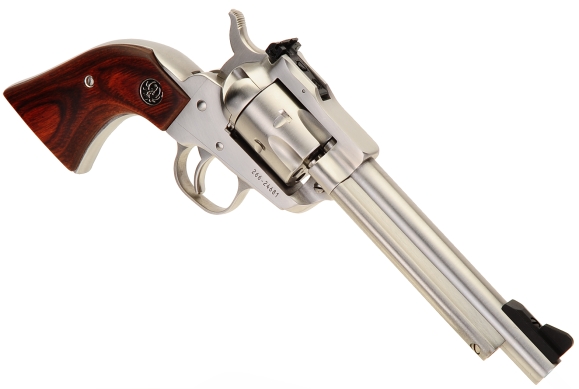
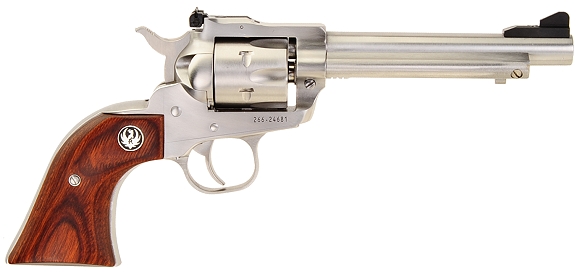

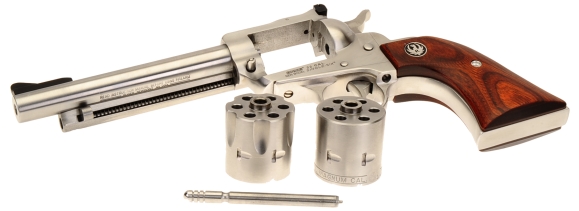
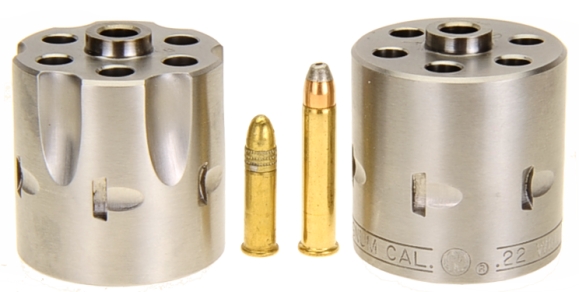

Email Notification